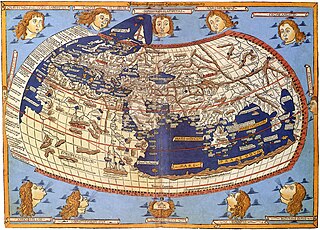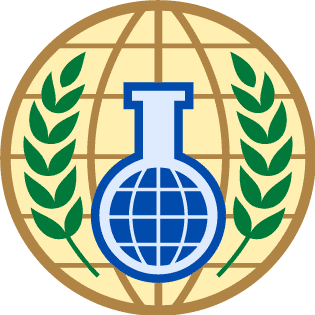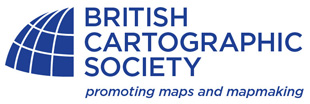
Cartography is the study and practice of making maps. Combining science, aesthetics, and technique, cartography builds on the premise that reality can be modeled in ways that communicate spatial information effectively.

The Organisation for the Prohibition of Chemical Weapons (OPCW) is an intergovernmental organisation and the implementing body for the Chemical Weapons Convention, which entered into force on 29 April 1997. The OPCW, with its 193 member states, has its seat in The Hague, Netherlands, and oversees the global endeavour for the permanent and verifiable elimination of chemical weapons.

Topography concerns the shape and character of the Earth's surface and maps were among the first artifacts to record these observations.They are also known as topographical maps. In modern mapping, a topographic map or topographic sheet is a type of map characterized by large-scale detail and quantitative representation of relief, usually using contour lines, but historically using a variety of methods. Traditional definitions require a topographic map to show both natural and artificial features. A topographic survey is typically based upon systematic observation and published as a map series, made up of two or more map sheets that combine to form the whole map. A topographic map series uses a common specification that includes the range of cartographic symbols employed, as well as a standard geodetic framework that defines the map projection, coordinate system, ellipsoid and geodetic datum. Official topographic maps also adopt a national grid referencing system.

A curator is a manager or overseer. Traditionally, a curator or keeper of a cultural heritage institution is a content specialist charged with an institution's collections and involved with the interpretation of heritage material including historical artifacts.

The Eastern Hemisphere is a geographical term for the half of Earth which is east of the prime meridian and west of the antimeridian. It is also used to refer to Afro-Eurasia and Australia, in contrast with the Western Hemisphere, which includes mainly North and South America. The Eastern Hemisphere may also be called the "Oriental Hemisphere". In addition, it may be used in a cultural or geopolitical sense as a synonym for the "Old World".
The North American Cartographic Information Society (NACIS) is a US-based cartographic society founded in 1980. It was founded by specialists in cartography, which included government mapmakers, map librarians, cartography professors and cartography lab directors. It now represents a broad mixture of academic, government and commercial interests, with a sizeable proportion of working cartographers. Many NACIS members come from related vocations

Arthur H. Robinson was an American geographer and cartographer, who was professor in the Geography Department at the University of Wisconsin–Madison from 1947 until he retired in 1980. He was a prolific writer and influential philosopher on cartography, and one of his most notable accomplishments is the Robinson projection of 1961.
A hackathon is a design sprint-like event; often, in which computer programmers and others involved in software development, including graphic designers, interface designers, project managers, domain experts, and others collaborate intensively on software projects.

Demeter International is the largest certification organization for biodynamic agriculture, and is one of three predominant organic certifiers. Its name is a reference to Demeter, the Greek goddess of grain and fertility. Demeter Biodynamic Certification is used in over 50 countries to verify that biodynamic products meet international standards in production and processing. The Demeter certification program was established in 1928, and as such was the first ecological label for organically produced foods.
The Australian Mathematical Society (AustMS) was founded in 1956 and is the national society of the mathematics profession in Australia. One of the Society's listed purposes is to promote the cause of mathematics in the community by representing the interests of the profession to government. The Society also publishes three mathematical journals. As of 2020, the Society's president is Professor Jacqui Ramagge, who was elected in 2018. In December 2020, Professor Ole Warnaar will move from President-Elect to President.
The Clean Air Society of Australia and New Zealand (CASANZ) is a non-governmental, non-profit organization formed in the 1960s to bring together people with an interest in clean air and the study of air pollution. Its focus has since grown to include broader environmental management affairs, but with special emphasis on air quality and related issues.
Chris Smith - "the Naked Scientist" - is a British consultant virologist and a lecturer based at Cambridge University where he is a fellow commoner of Queens' College. He is also a science radio broadcaster and writer, and presents the Naked Scientists, a programme which he founded in 2001, for BBC Radio and other networks internationally, as well as 5 live Science on BBC Radio 5 Live.
SAHANZ was founded in South Australia in 1984. It is a scholarly society for the advancement of research into the history of architecture, with a focus on New Zealand, Australia and the South Pacific. It holds an annual conference and produces a journal, Fabrications. The current President is Paul Hogben, from UNSW.

The International Cartographic Association (ICA), is an organization formed of national member organizations, to provide a forum for issues and techniques in cartography and GIScience. ICA was founded on June 9, 1959, in Bern, Switzerland. The first General Assembly was held in Paris in 1961. The mission of the International Cartographic Association is to promote the disciplines and professions of cartography and GIScience in an international context. To achieve these aims, the ICA works with national and international governmental and commercial bodies, and with other international scientific societies.
The Australasian Society for Historical Archaeology (ASHA) was founded as the Australian Society for Historical Archaeology in 1970 by Judy Birmingham. Its aims are to promote the study of historical archaeology in Australia.

The British Cartographic Society (BCS) is an association of individuals and organisations dedicated to exploring and developing the world of maps. It is a registered charity. Membership includes mapping companies, publishers, designers, academics, researchers, map curators, individual cartographers, GIS specialists and ordinary members of the public with an interest in maps.
The Australasian Association of Philosophy (AAP) is the peak body for philosophy in Australasia. The chief purpose of the AAP is to promote philosophy in Australia, New Zealand, and Singapore. Among the means that it follows to achieve this end, the AAP runs an annual conference, publishes two journals, awards various prizes, sponsors postgraduate and undergraduate philosophical activities, maintains affiliations with numerous other organisations that aim to promote philosophy and philosophical activity, and promotes philosophy in schools, cafes, pubs, and everywhere else that philosophy may be found.
GLAM is an acronym for "galleries, libraries, archives, and museums", and refers to cultural institutions with a mission to provide access to knowledge. GLAMs collect and maintain cultural heritage materials in the public interest. As collecting institutions, GLAMs preserve and make accessible primary sources valuable for researchers.
The CRC for Spatial Information (CRCSI) is a research organisation funded by Australia's Cooperative Research Centre Programme (CRC) and by participant contributions. The CRCSI was founded in 2003 with the successful rebid announced in August 2009. It will continue to June 2018. The CRCSI conducts research and development projects that involve collaboration between government, corporate and academic resources.









